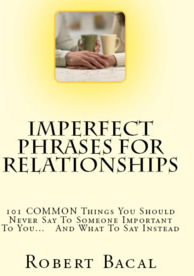All Couples Should Learn To FIght Fair. Here's How
Check out our mini-guide on how to fight fair, and stop letting badly handled conflict cause pain in your relationships. Download it NOW!
Search Our Network Of Business and Personal Development Sites
Control - Acknowledge - Refocus - Problem Solve - Conflict Resolution Model
Using The CARP System To Manage Conflict Constructively - Part I (Control) By Robert Bacal
Summary: In this three part article Robert presents a simple four stage model for dealing with difficult, aggressive and challenging people. Originally designed for application to difficult customers, the model fits for many other situations.
Editor's Note. This is part of a three part series. To view parts two and three, click the links at the bottom of the article.
Disagreements, conflicts and disputes, either mild or severe are elements of life that we all have to face on a regular basis. It's part of being human and interacting with others. Most of us don't look forward to conflict, but it's something we can use to improve our relationships and work performance. Or, it is something that we can manage poorly and end up with destructive outcomes. It's all in how it's managed.
The C*A*R*P model was originally developed by Robert Bacal as an aid to teaching people a simple strategy for dealing with difficult, hostile and aggresive customers. But it's not limited to that context. In fact it can be used to guide our behavior and reactions during conflict situations so that we end up with constructive outcomes rather than destructive ones. In Part I, we'll discuss the "C" part; which stands for CONTROL. We'll cover the rest of the model in subsequent newsletters.
Before we go into detail about the "C", here's the whole model. C stands for Control, A for Acknowledge, R for Refocus, and P for Problem-Solve.What's really important is that the order is critical. For example, you can't problem-solve until the situation/conversation is "under control".
C is For Control
There are several parts to a conflict situation. First, and most obviously, there is the conflict ISSUE, or content of the conflict. The conflict content refers to the specific issue about which the conflicting parties disagree. If that's all that happened in conflict situations, things would be a lot easier. But the second part is the EMOTIONAL part. People in conflict experience varying degrees of emotional upset. Sometimes it's small. Sometimes it's not so small, and our emotional reactions depend on a wide range of factors, including our general personalities, the importance of the conflict, nature of the relationship with the other party, and even whether we're just having a bad day.
Regardless of the source, the emotions commonly associated with conflict (anger, frustration, resentment, and even depression) usually interfere with working through the problem ISSUE and working out a constructive solution. The feelings also create more bad feelings, creating a cycle of escalation that must be broken if constructive things are going to happen. When both parties get sucked into an emotional vortex, there's no hope of success.
So the first priority in conflict situations is to CONTROL the emotional climate and behaviors occurring. Clearly, you can't "control" the emotional reactions and behavior of the other party, but you can exert some positive influence. And, of course, you need to control your own emotions and behaviors to create a playing field where it's more likely that you can address the conflict issue and not get hooked into emotional highly charged interactions.
So, you need to exert control over yourself and your behaviors, and you need to apply some direction that is likely to reduce the emotional behavior of the other party. It's absolutely essential to any conflict.
Self-control is always difficult in conflict situations. It doesn't mean you can't feel emotions, but it does mean that you have to manage your behavior so your initial, almost reflex like reactions don't ever come into play. Here's a tip. As you get angry or upset in a conflict, your first gut feelings about what to say or do will almost always escalate the conflict and make both you and the other party more upset. So, a major part of self-control involves slowing down your responses and letting the "thinking" part of your brain get onto the playing field. Slow down and think. Before you utter the insult, or go far afield to win the argument (which doesn't work) consider the EFFECT of what you want to say. Ask yourself: "If I say that, is the situation going to get better or worse?" Then act accordingly.
Keep in mind that in the heat of the moment, your emotional reactions seem exceedingly important to you, and your focus will be on venting those emotions or serving them in some way IN THE MOMENT. If you shift your focus just a bit from "serving your emotions NOW" to solving the problem constructively without causing damage in the present AND the future, it gets easier.
So, self control is the first component of "C".
The second component has to do with how you exert influence on the other person. What you want to do is make sure you don't reward or reinforce aggressive or destructive behavior in the other person. One way to do this is to avoid focusing at all on emotional outbursts from the other party. When you focus on them, and respond to them, what happens is you end up rewarding the person for their destructive conflict behavior. One key here is ignore the "junk". Nobody wins when both parties go head to head in a knock down aggressive battle. So, do your best to remove the rewards your reactions provide.
There are a number of specific techniques associated with the "C" component and influencing others, but perhaps the easiest to master is timing. Recognize that there are times when the other person is simply not ready to put aside their emotions and actually address the conflict issue. There is nothing wrong with taking a time-out, or removing yourself from a conflict situation which is essentially out of control and fraught with aggressive behavior. Time-outs can range from a minute or two to get a drink of water or visit the washroom, or a ten minute cooling off period, to a postponement to another day.
Generally time-outs can be executed unilaterally, although it's best to present the time-out as an option so both of you can agree. Here's one way: "I'm thinking that we're both upset (or tired) and it's not a great time to discuss this. How about we take a break and talk about this again later today. Does that work for you?"
Notice the no-blame aspect here. We're not blaming the other person for having to stop, but taking on equal responsibility.
So, two major strategies here. First, don't reward destructive behavior by focusing on it, and recognize timing issues. If two conflicting parties are not ready to be constructive, there is absolutely no point in having destructive interactions.
Next time: more on the CARP system and conflict.
[View Part I] [View Part II] [View Part III]
For more on conflict check out our conflict related products at http://work911.com/products and in particular the book called Conflict Prevention In The Workplace - Using Cooperative Communication
© Copyright Robert Bacal, 2000 . Reproduction in any form, electronic or print is forbidden without obtaining permission.
 Manage Conflict - Resolve Conflict - Prevent Conflict
Manage Conflict - Resolve Conflict - Prevent Conflict 

